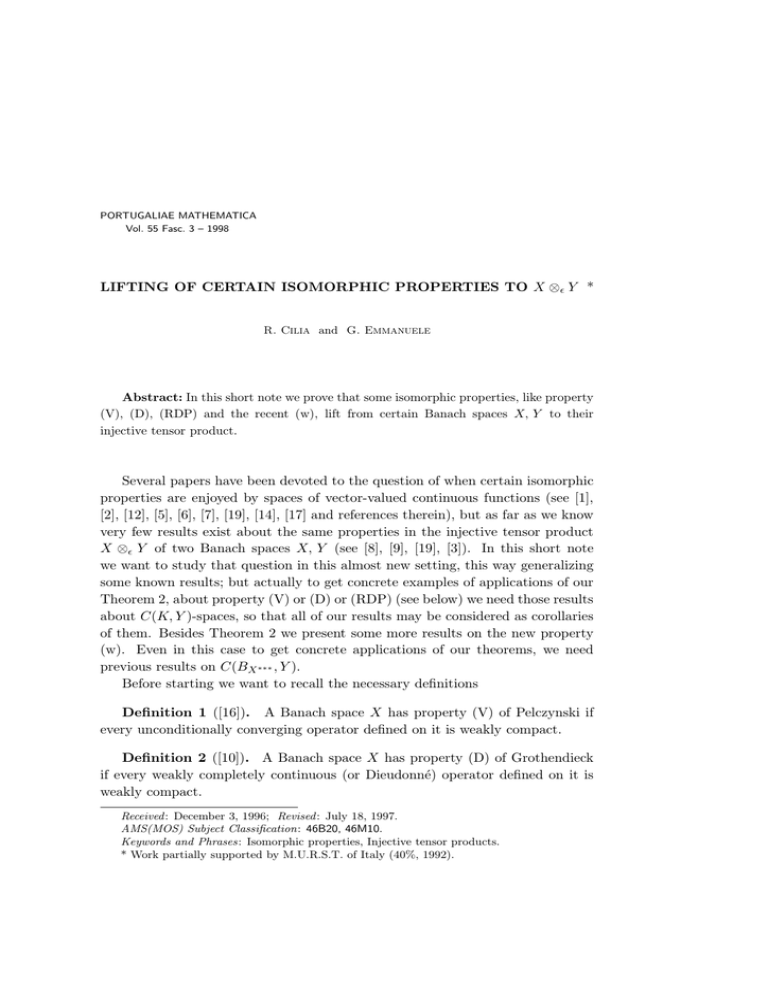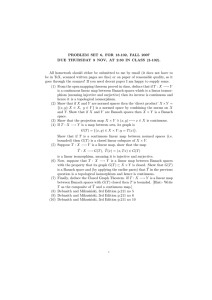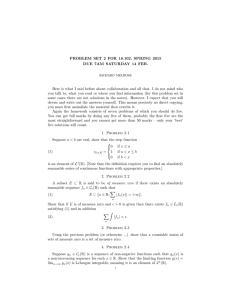LIFTING OF CERTAIN ISOMORPHIC PROPERTIES TO X ⊗ Y *
advertisement

PORTUGALIAE MATHEMATICA Vol. 55 Fasc. 3 – 1998 LIFTING OF CERTAIN ISOMORPHIC PROPERTIES TO X ⊗² Y * R. Cilia and G. Emmanuele Abstract: In this short note we prove that some isomorphic properties, like property (V), (D), (RDP) and the recent (w), lift from certain Banach spaces X, Y to their injective tensor product. Several papers have been devoted to the question of when certain isomorphic properties are enjoyed by spaces of vector-valued continuous functions (see [1], [2], [12], [5], [6], [7], [19], [14], [17] and references therein), but as far as we know very few results exist about the same properties in the injective tensor product X ⊗² Y of two Banach spaces X, Y (see [8], [9], [19], [3]). In this short note we want to study that question in this almost new setting, this way generalizing some known results; but actually to get concrete examples of applications of our Theorem 2, about property (V) or (D) or (RDP) (see below) we need those results about C(K, Y )-spaces, so that all of our results may be considered as corollaries of them. Besides Theorem 2 we present some more results on the new property (w). Even in this case to get concrete applications of our theorems, we need previous results on C(BX ∗∗∗ , Y ). Before starting we want to recall the necessary definitions Definition 1 ([16]). A Banach space X has property (V) of Pelczynski if every unconditionally converging operator defined on it is weakly compact. Definition 2 ([10]). A Banach space X has property (D) of Grothendieck if every weakly completely continuous (or Dieudonné) operator defined on it is weakly compact. Received : December 3, 1996; Revised : July 18, 1997. AMS(MOS) Subject Classification: 46B20, 46M10. Keywords and Phrases: Isomorphic properties, Injective tensor products. * Work partially supported by M.U.R.S.T. of Italy (40%, 1992). 272 R. CILIA and G. EMMANUELE Definition 3 ([10]). A Banach space X has property (RDP) of Grothendieck if every completely continuous (or Dunford–Pettis) operator defined on it is weakly compact. Definition 4 ([19]). A Banach space X has property (w) of Saab and Saab if every operator from it into its dual is weakly compact. Our first result is about property (V). In order to get it we need the following Lemma 1. Suppose E, F are two Banach spaces such that there is a norm one quotient map Q : E → F for which the range Q∗ (F ∗ ) of Q∗ is a norm one complemented subspace of E ∗ . Consider another Banach space Y and suppose that the following assumptions are verified: (a) E ∗ or Y ∗ has the approximation property. (b) E ∗ or Y ∗ has the Radon–Nikodym property. Then the mapping Q ⊗² idY : E ⊗² Y → F ⊗² Y is a quotient mapping. Proof: Thanks to our assumptions (a) and (b) we have the following isometries (E ⊗² Y )∗ = E ∗ ⊗π Y ∗ , (F ⊗² Y )∗ = F ∗ ⊗π Y ∗ (see [4]). The mapping Q∗ ⊗π idY ∗ : F ∗ ⊗π Y ∗ → Q∗ (F ∗ ) ⊗π Y ∗ clearly is an isometry onto; since the range space of it is a closed subspace of E ∗ ⊗π Y ∗ (because Q∗ (F ∗ ) is norm one complemented into E ∗ ) the mapping Q∗ ⊗π idY ∗ : F ∗ ⊗π Y ∗ → E ∗ ⊗π Y ∗ is an isometry into; but it clearly is the conjugate operator of the mapping Q ⊗² idY that is so a quotient mapping from E ⊗² Y onto F ⊗² Y . We are done. We are now ready to prove the first result; in it we shall denote by ∆ the Cantor set Theorem 2. Let X be a Banach space such that X ∗ is isometric to a L1 space and Y be a Banach space with property (V) of Pelczynski. Then X ⊗² Y has property (V) of Pelczynski. Proof: Let T : X ⊗² Y → Z be an unconditionally converging operator and (xn ) a bounded sequence in X ⊗² Y ; it will be shown that (T (xn )) allows a weakly convergent subsequence. Since for every separable subspace E ⊂ X there is a separable L1 -predual subspace F ⊂ X with E ⊂ F (see [13], p.232), there is a separable L1 -predual subspace X0 of X such that (xn ) is contained in LIFTING OF CERTAIN ISOMORPHIC PROPERTIES TO X ⊗² Y 273 X0 ⊗² Y . Because of the density of the (not complete) tensor product X0 ⊗ Y inside X0 ⊗² Y , we can find a bounded sequence zn ∈ X0 ⊗ Y such that kxn − zn k² → 0 . For each n ∈ N, choose a finite dimensional Banach subspace Yn of Y so that zn ∈ X0 ⊗² Yn . Now a result in [11] states that there is a norm one quotient mapping Q from C(∆) onto X0 . Consider the mappings Q ⊗² idYn : C(∆) ⊗² Yn → X0 ⊗² Yn . Since X0∗ and C(∆)∗ are L1 -spaces, the range of the isometry (into) Q∗ : X0∗ → C(∆)∗ is a norm one complemented subspace of C(∆)∗ (this is a consequence of a result going back to T. Ando; see [13], p.162); this and the finite dimensionality of each Yn allow us to apply Lemma 1: the mappings Q ⊗² idYn are quotient mappings. We may find a bounded sequence (fn ) ⊂ C(∆, Y ) with each fn belonging to the corresponding C(∆) ⊗² Yn (a subspace of C(∆, Y )) such that (Q ⊗² idYn )(fn ) = zn for all n ∈ N; hence (Q ⊗² idY )(fn ) = zn for all n ∈ N. By assumption T ◦ (Q ⊗² idY ) is unconditionally converging and hence weakly compact, since C(∆, Y ) has Pelczynski property (V) by a result of Randriantoanina ([17]), so that also [T ◦ (Q ⊗² idY )](fn ) = T (zn ) is a relatively weakly compact sequence. We are done, thanks to the choice of (zn ). Similar results, with similar proofs, can be obtained for the other two properties (D) and (RDP). Applying the results in [2], [12], [5], [6], [7] we have concrete examples of spaces Y for which X ⊗² Y has one of the first three properties. We underline that among the results quoted at the beginning that one in the paper [3] is obtained with Y reflexive (a more restrictive assumption than that considered in [2]) but with X a L∞ -space, instead of a space with dual isometric to a L1 -space. In the next results, we turn our attention to property (w); a first result is the following Theorem 3. Let X be a L∞ -space and Y be a Banach space such that C(BX ∗∗∗ , Y ) has property (w). Then X ⊗² Y has property (w). Proof: Let T : X ⊗² Y → (X ⊗² Y )∗ be. We consider the restriction Te of T ∗∗ to X ∗∗ ⊗² Y that is a closed subspace of (X ⊗² Y )∗∗ , as proved in [8]; hence Te takes X ∗∗ ⊗² Y into (X ⊗² Y )∗∗∗ . As in [8], there is a norm one projection R of C(BX ∗∗∗ , Y ) onto X ∗∗ ⊗² Y , so that Te ◦ R : C(BX ∗∗∗ , Y ) → (X ⊗² Y )∗∗∗ . Now, let us consider the canonical projection P of (X ⊗² Y )∗∗∗ onto (X ⊗² Y )∗ , 274 R. CILIA and G. EMMANUELE that in turn is isometrically embedded into (X ∗∗ ⊗² Y )∗ (see [4], Ch.VIII) by an isometric embedding i. So the operator F = R∗ ◦i◦P ◦Te ◦R takes C(BX ∗∗∗ , Y ) into (C(BX ∗∗∗ , Y ))∗ . Thanks to our assumption on Y such an F is weakly compact. Now, let us consider an arbitrary element z in BX⊗² Y , the unit ball of X ⊗² Y . It is clear that (Te ◦R)(z) = T (z). Furthermore, T (z) ∈ (X ⊗² Y )∗ and so P [T (z)] = T (z), for all z ∈ BX⊗² Y . These remarks imply that F (z) = (R∗ ◦ i ◦ T )(z) for all z ∈ BX⊗² Y , from which it follows that (R∗ ◦ i ◦ T )(BX⊗² Y ) ⊂ F (BX⊗² Y ). Since both R∗ and i are isometries, the relative weak compactness of F (BX⊗² Y ) gives that of T (BX⊗² Y ). We are done. Corollary 4. Let X be a L∞ -space and let Y be a Banach space. Then X ⊗² Y has property (w) if Y has either of the following properties: (a) Y has property (u) ([15]) and contains no subspace isomorphic to l1 . (b) Y is complemented in a Banach lattice and has property (w). (c) Y is a closed subspace of an order continuous Banach lattice and has property (w). (d) Y ∗ and Y ∗∗ have the Radon–Nikodym property and Y has property (w). Then X ⊗² Y has property (w). Proof: It is enough to note that under either of the cases (a), (b), (c) or (d) the space C(BX ∗∗∗ , Y ) has property (w). As a matter of fact, case (a) follows from [2], cases (b) and (c) follow from [19] and case (d) follows from [14]. This Corollary 4 allows us to extend Proposition 12 in [19] obtained for X ∗ isometric to a L1 -space and Y a Banach lattice. REFERENCES [1] Cembranos, P. – On Banach spaces of vector valued continuous functions, Bulletin of the Australian Mathematical Society, 28 (1983), 175–186. [2] Cembranos, P., Kalton, N.J., Saab, E. and Saab, P. – Pelczynski’s property (V) on C(Ω, E) spaces, Mathematischen Annalen, 271 (1985), 91–97. [3] Cilia, R. – About the properties (V) and (RDP) in injective tensor products, to appear on Rendiconti Circolo Matematico di Palermo. [4] Diestel, J. and Uhl jr., J.J. – Vector Measures, Math. Surveys 15, Amer. Math. Soc., 1977, Providence, Rhode Island. [5] Emmanuele, G. – On the Banach spaces with the property (V∗ ) of Pelczynski, Annali di Matematica Pura e Applicata, 152 (1988), 171–181. LIFTING OF CERTAIN ISOMORPHIC PROPERTIES TO X ⊗² Y 275 [6] Emmanuele, G. – Another proof of a result of N.J. Kalton, E. Saab and P. Saab on the Dieudonné property in C(K, E), Glasgow Mathematical Journal, 31 (1989), 137–140. [7] Emmanuele, G. – On Banach spaces with the property (V∗ ) of Pelczynski, II, Annali di Matematica Pura e Applicata, 160 (1991), 163–170. [8] Emmanuele, G. – Remarks on weak compactness of operators defined on certain injective tensor products, Proceedings of the American Mathematical Society, 116 (1992), 473–476. [9] Emmanuele, G. – Addendum to “Remarks on weak compactness of operators defined on certain injective tensor products”, Proceedings of the American Mathematical Society, 118 (1993), 335. [10] Grothendieck, A. – Sur les applications lineaires faiblement compactes d’espaces du type C(K), Canadian Journal of Mathematics, 5 (1953), 29–173. [11] Johnson, W.B. and Zippin, M. – Separable L1 -preduals are quotients of C(∆), Israel Journal of Mathematics, 16 (1973), 198–202. [12] Kalton, N.J., Saab, E. and Saab, P. – On the Dieudonné property for C(K, E), Proceedings of the American Mathematical Society, 96 (1986), 50–52. [13] Lacey, H.E. – The isometric theory of classical Banach spaces, GMW 208, Springer Verlag, 1974, Berlin, Heidelberg, New York. [14] Leung, D.H. – Banach spaces with property (w), Glasgow Mathematical Journal, 35 (1993), 207–217. [15] Pelczynski, A. – A connection between unconditional convergence and weak completeness of Banach spaces, Bulletin of the Polish Academy of Sciences, 6 (1958), 251–253. [16] Pelczynski, A. – Banach spaces on which every weakly unconditionally converging operator is weakly compact, Bulletin of the Polish Academy of Sciences, 10 (1962), 641–648. [17] Randrianantoanina, N. – Pelczynski’s property (V) on spaces of vector valued functions, preprint, 1994. [18] Saab, E. and Saab, P. – On Pelczynski’s properties (V) and (V ∗ ), Pacific Journal of Mathematics, 125 (1986), 205–210. [19] Saab, E. and Saab, P. – Extensions of some classes of operators and applications, Rocky Mountain Journal of Mathematics, 23 (1993), 319–337. R. Cilia and G. Emmanuele, Department of Mathematics, University of Catania, Viale A. Doria 6, 95125 Catania – ITALY



